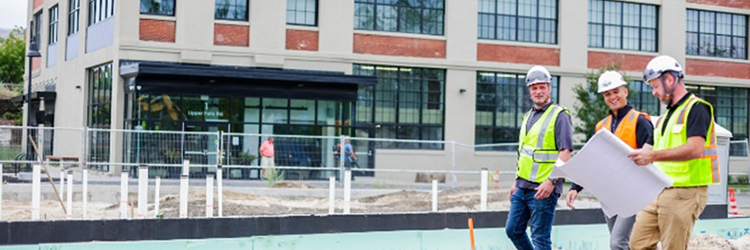Southern New Hampshire continues to be a growth story - by Michael Harrington

The Southern New Hampshire real estate market continues to show sustainable growth and future economic development due in part to smart urban planning. Once primarily known for its bedroom communities and proximity to Boston, the region has emerged as a magnet for businesses, developers, and new residents alike. The transformation is being driven by three key factors: close cooperation with local authorities and city planners, major infrastructure investments such as the widening of I-93 and expanded municipal utilities, and a willingness by planning boards to adapt local land use regulations and approve large-scale, master-planned, mixed-use communities. Together, these elements have created fertile ground for high-profile mixed-use projects like Tuscan Village in Salem, Woodmont Commons in Londonderry, and Market & Main in Bedford.
A hallmark of Southern New Hampshire’s recent growth has been the productive relationships forged between developers and municipal leaders. Town officials across the region have embraced collaborative planning processes, recognizing that well-coordinated projects can enhance both quality of life and economic opportunity. Developers cite the value of early and ongoing engagement with town boards, economic development offices, and planners as crucial to aligning private vision with public goals.
In the case of Woodmont Commons — a 600-acre mixed-use project featuring residential, commercial, and retail components — developer Pillsbury Realty Development worked closely with local officials to craft a comprehensive master plan. Through dozens of public meetings and workshops, the town and developer jointly established a framework that preserved community character while enabling modern, walkable development.
No growth story in Southern New Hampshire would be complete without acknowledging the role of infrastructure. The $800 million widening of I-93, completed over the last decade by the State of N.H. DOT, has vastly improved mobility throughout the corridor from Salem to Manchester. With additional travel lanes, rebuilt interchanges, and improved exits, this key artery now supports increased traffic without the gridlock that once hampered the region’s economic potential.
Additionally, towns have made strategic investments in municipal water and sewer systems — two assets often overlooked but essential for higher-density development. Salem, for example, extended municipal sewer and water access to accommodate the Tuscan Village project, a 170-acre, $1 billion lifestyle center built on the former Rockingham Park racetrack site. By proactively upgrading utilities, the town laid the groundwork for one of New England’s most ambitious mixed-use developments, which now includes luxury apartments, office space, a medical campus, hotel, restaurants, and an expansive retail plaza anchored by major national brands.
Southern New Hampshire communities have also shown commendable flexibility in evolving their land use codes to accommodate changing market conditions. Where once zoning may have restricted mixed-use or higher-density development, towns have revised ordinances to encourage innovation, smart growth, and economic resilience. A project I’m intimately familiar with, as an appointed member of the advisory board, is the city of Manchester’s update to its land use regulations. The director of planning is taking a pro-active approach to revise its 20-year-old land use regulations with a goal of having the new regulations presented to the board of mayor and aldermen by the end of 2025.
Market & Main is another example of this forward-thinking approach. The redevelopment of a former Macy’s site into a vibrant mixed-use center was made possible by Bedford’s willingness to create a Performance Zone overlay that allows for integrated retail, office, and residential uses. This flexibility has not only attracted high-end retailers and restaurants but has also redefined Bedford’s Rte. 3 corridor as a destination rather than a pass-through.
Similarly, Londonderry’s innovative zoning overlay for Woodmont Commons provides for a traditional neighborhood development pattern, allowing a mix of housing types, public green spaces, and retail within walking distance. By prioritizing form-based codes and flexible site planning, the town facilitated a design that feels both modern and rooted in New England character.
Together, Tuscan Village, Woodmont Commons, and Market & Main offer tangible proof of what’s possible when infrastructure, planning cooperation, and zoning flexibility align. These projects not only bring jobs, housing, and tax revenue but also enhance the quality of life by creating vibrant, livable communities with walkability, access to services, and lifestyle amenities.
As growth pressures mount across the Northeast, Southern New Hampshire’s model provides important lessons: smart infrastructure investments are essential; proactive, open dialogue between developers and municipalities builds trust and better outcomes; and flexible, adaptive zoning empowers communities to evolve with the times.
With several more projects on the horizon and continued investment in regional connectivity, Southern New Hampshire is not just growing — it is thriving. And its success offers a blueprint for thoughtful, sustainable development throughout New England and beyond.
Michael Harrington, CRE, CCIM, RPA, is a principal of Harrington & Company, Manchester, N.H.
Reveler Development celebrates final phase of work at The Levee - new 51-unit apartment building in Biddeford


The Greater Portland industrial mid-year market update - by Nate Roop

Maine multifamily outlook: Opportunities in Portland, Bangor, and Lewiston-Auburn - Blake Wright and Kristie Russell
The multifamily market in Maine’s major cities presents a diverse range of opportunities for investors. We looked at the potential benefits and unique characteristics of three major submarkets in the state: Portland, Bangor, and Lewiston-Auburn. The information below is based on research done in CoStar and county registries, and focuses on multifamily properties that have four or more units.

Interest rates and inflation - by Matthew Bacon
As we all know, interest rates have been changing drastically, with movement in both directions, depending on the type and term of financing. The Federal Open Market Committee has taken drastic action in efforts to curb abnormally high inflation, but it hasn’t controlled labor cost growth to the extent that was intended.


 (1) (1).png)





.png)


.png)